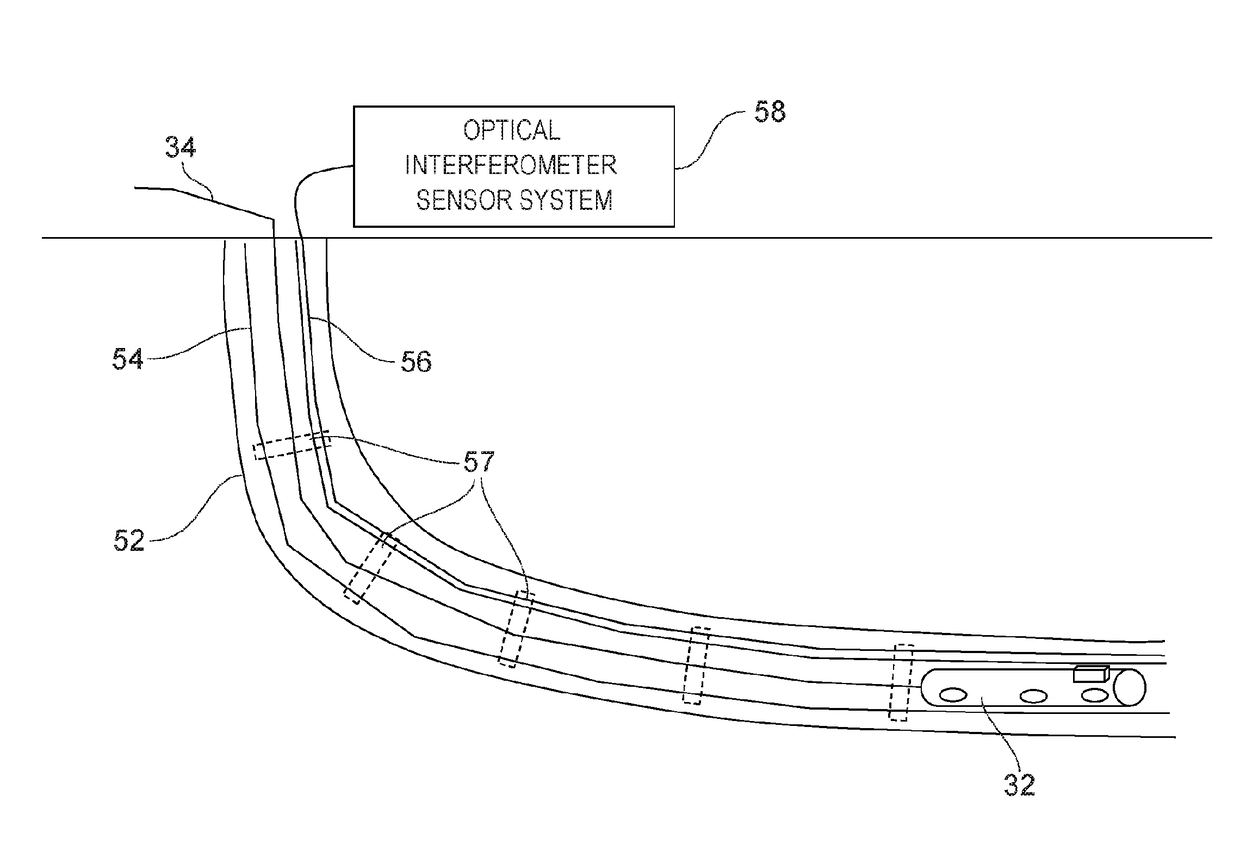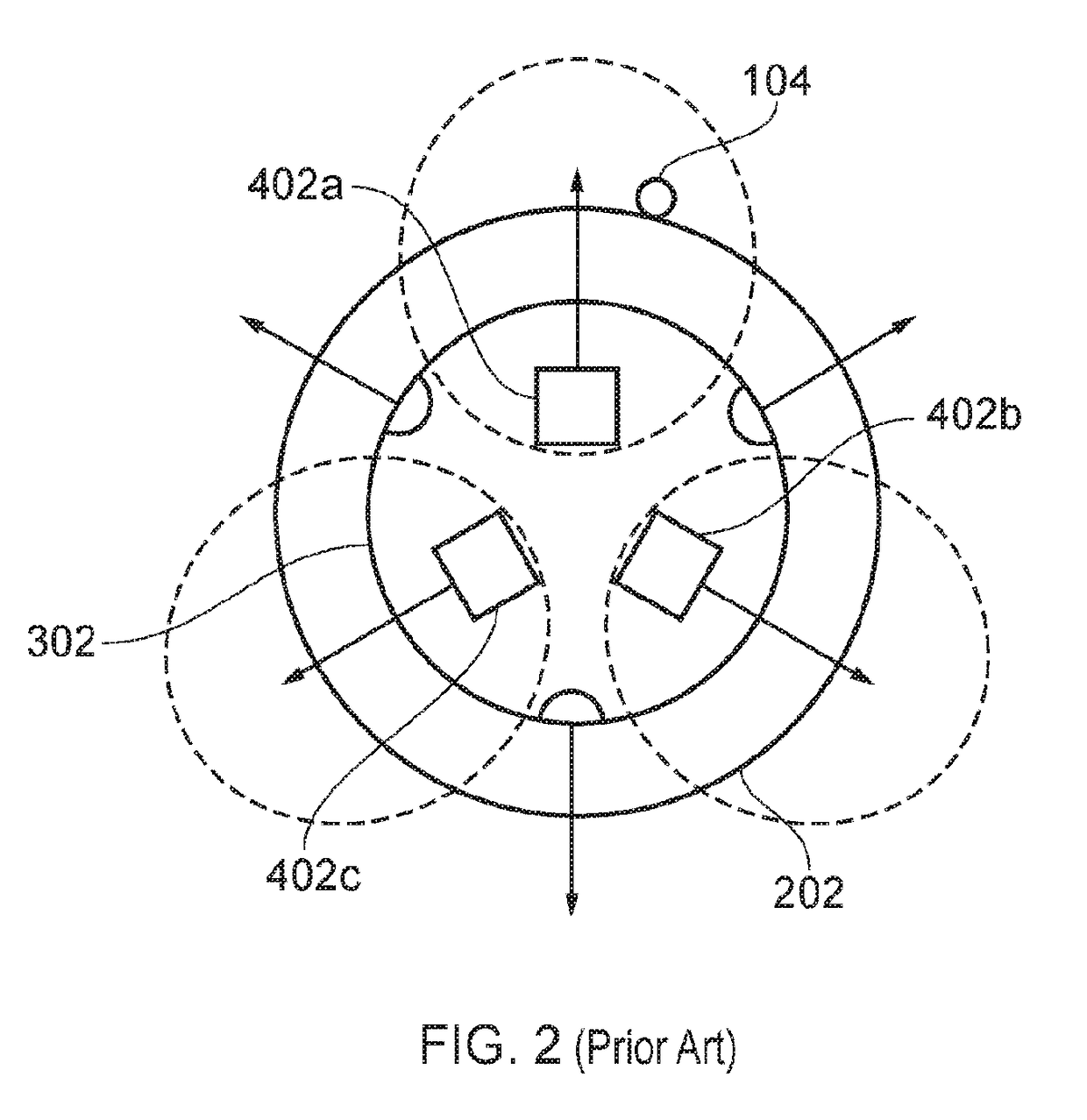Method and system for determining downhole optical fiber orientation and/or location
a technology of optical fiber and orientation or location, which is applied in the direction of electrical/magnetic detection for well-logging, fluid removal, survey, etc., can solve the problems of increasing the material and production cost of the well, affecting the accuracy of the use of magnetometers to detect rods, and affecting the accuracy of the determination. , to achieve the effect of accurate determination
- Summary
- Abstract
- Description
- Claims
- Application Information
AI Technical Summary
Benefits of technology
Problems solved by technology
Method used
Image
Examples
first embodiment
[0064]the present invention will be described with respect to FIGS. 4a and 4b.
[0065]FIG. 4a illustrates that the transducer 36 may be an electrical or mechanical tapper device 36a, that is arranged to rotate about an axis and tap at discrete points on the inner surface of casing 54 as it rotates through 360 degrees. In this embodiment the optical interferometric sensing system 58 operates as a distributed acoustic sensor (DAS), which listens to the acoustic energy from the taps and determines its amplitude and / or power. A plot of the measured amplitude and / or power with respect to angular position of the tapper as it rotates within the casing is made, as shown in FIG. 4b. With reference to the orientational axes shown in FIG. 4a, a minima in the measured amplitude or power plot is expected when the tapper is aligned with the x-axis of FIG. 4a i.e. when it is substantially orthogonal to the position of the optic fiber 56, whilst a primary maxima in amplitude or power is obtained whe...
second embodiment
[0067]the invention will now be described with respect to FIGS. 6a and 6b. In this embodiment the optical interferometric sensing system 58 operates as a distributed temperature sensor (DTS) that acts to determine the temperature of the casing 54, inter alia. The transducer 36 is a heated probe, similar to the tip of a soldering iron, that is rotationally mounted on the perforating gun, or alternatively on another down-hole device that acts as a carriage for the probe. In some embodiments this may be preferable, so that the heated tip is not maintained near the explosives that are contained within the perforating gun. The heated probe is in contact with the inner surface of the casing 54, and acts to heat the casing wall in the immediate vicinity of the probe. The degree of local heating provided by the probe need not be large, and may even be less than 1K, for the reason that modern DTS systems have very high temperature resolutions, as high as 0.01K.
[0068]The local heating of the ...
third embodiment
[0072]the invention will now be described with respect to FIGS. 8a and 8b. In this embodiment the optical interferometric sensing system 58 operates as a distributed temperature sensor (DTS) that acts to determine the temperature of the casing 54, inter alia. The transducer 36 is a probe with a heated tip 36c and a cooled tip 36d, wherein the probe is heated on one side and cooled on the opposite side, that is rotationally mounted on a perforating gun, or alternatively on another down-hole device that acts as a carriage for the probe. In some embodiments this may be preferable, so that the heated part of the probe is not maintained near the explosives that are contained within the perforating gun. The probe is in contact with the inner surface of the casing 54, and acts to heat or cool the casing wall in the immediate vicinity of the probe. The degree of local heating provided by the probe need not be large, and may even be less than 1K, for the reason that modern DTS systems have v...
PUM
| Property | Measurement | Unit |
|---|---|---|
| length | aaaaa | aaaaa |
| frequencies | aaaaa | aaaaa |
| frequencies | aaaaa | aaaaa |
Abstract
Description
Claims
Application Information
 Login to View More
Login to View More - R&D
- Intellectual Property
- Life Sciences
- Materials
- Tech Scout
- Unparalleled Data Quality
- Higher Quality Content
- 60% Fewer Hallucinations
Browse by: Latest US Patents, China's latest patents, Technical Efficacy Thesaurus, Application Domain, Technology Topic, Popular Technical Reports.
© 2025 PatSnap. All rights reserved.Legal|Privacy policy|Modern Slavery Act Transparency Statement|Sitemap|About US| Contact US: help@patsnap.com



